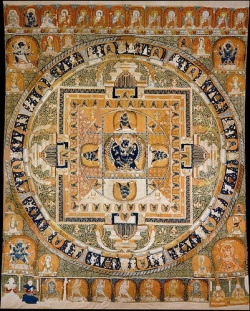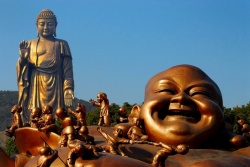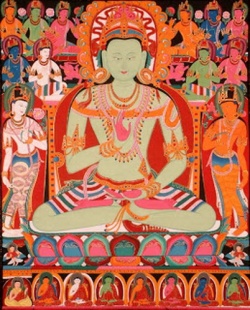Mahayanic Gods
In his endeavour to approach a higher, unknown and unknowable Power, mankind has found in the Idol and in the Word the two most significant symbols. The Idol is the outcome of a definite choice out of the various phenomena of the visual world; in this chosen image a specific aspect of the mysterious Power is considered to be embodied. The Word, on the other hand, is a special but involuntary combination of a few of the many sounds to be distinguished by the ear, which combination then implies a special meaning.
As forms of expression of a higher Power, the Idol and the Word are therefore identical. Religious feeling has always sensed this identity, both in its philosophical aspect, which finds its expression in a combination like Logos and Theos, and in its magical aspect, to which in India a special branch of Northern Buddhism has been devoted.
Perhaps this similarity between Idols and Words is the cause of both having been subjected to vicissitudes so variegated and incalculable, that it will in most cases prove to be impossible, given the form and meaning which we now find inherent to either of them, to arrive at a complete semantic reconstruction of the world of thought which was embodied in an Idol or in a Word. Suppose, for instance, that a word is taken over from one language into another and that the meaning, the conception it conveys, or, in short, the whole world of thought which it connotes, has been entirely altered through misapprehension or local adaptation. if then in the course of time the word should be found to be in use in both languages, it will be generally possible to state for a fact which language has been the borrower; but a very scholarly and painstaking research would be required for the reconstruction of the semantic history which is attached to this fact. This is only an example of a very simple case; generally the problem is much more complicated.
At least as complicated is the semantic research concerning an Idol. In linguistics one can at least count on relatively concrete data, such as, for instance, texts from different periods in which a word occurs in various connections. But in the search after the history of the conceptions which are symbolized by an Idol, even comparative data afford insufficient support. One must pick a way through a labyrinth of subtle associations and conjectured tendencies, in which cause and effect can hardly be distinguished, since everything here is born of the subconscious, which stands quite outside the ordinary pale of intellect and logic. The number of possibilities obtaining here is stupendous. Suppose for instance that in a certain culture-area an Idol is met with, which in different periods is connected with diametrically opposite conceptions. In such a case it may be proved that one has to deal with a quaint evolution of one and the same idea, which evolution may then have been caused by cultural or sociological factors, as when a nomadic people would take to agriculture, etc. But it could also be, that such a thorough divergence in the conception attached to an Idol might be ascribed to the fact that through various circumstances this Idol became the embodiment of two originally quite different ideas: in the first place the idea with which the image was originally connected in a certain culture-area, and secondly the underlying thought of another god in quite another culture-area, at some later date introduced in the former area through political agencies, such as for instance enemy invasion. Owing to the fact that the native Idol happened to bear a name more or less similar in sound perhaps, or more or less resembled the intruding Idol in appearance, it was apt to be looked upon as the same in character and function, and after some time even to be quite supplanted by the new Idol. And here again we have stated only two of a long series of possibilities.
From the above it follows that it is impossible to embrace the nature of an Idol entirely in a single definition. We can not say, for instance: "X. is a God of Thunder", but at the most we can say "in such and such a time and place, X. was looked upon as a God of Thunder". This applies equally to the religions of a highly cultured people as to the religions of peoples of a more archaic order; even more so to the first-named, where there exists a stronger tendency towards limitation and definition, with a consequent loss of minor deviations or special traits, which might have been of much aid to the investigator in the course of his research.
In commencing my study on the Mantrayanic aspect of the god Hayagriva it seemed incumbent upon me to make the above express reservation.
The Mantrayana is one of the many later forms of development of northern Buddhism, which are usually indicated by the name Tan trism. It appears to me, however, better not to use tho word Tantrisin in this study; for since nobody knows exactly what it means, it is apt to cause much confusion. Most modern scholars therefore never use the word without adding an observation as to its vague meaning. Some late-çivaist works, in which the worshipping of the female energy of the god was brought into strong prominence, bore the very general name of Tantra, a word which by itself does not mean more than a theoretical, scientific work (or a chapter thereof), a collection of instructions or rules (cf. for instance Ka-tantra, Panca-tantra etc.). From this word the term Tantrism was deduced, which at the same time came to be applied to caktic tendencies in later Buddhism, and soon afterwards was used in Buddhology and elsewhere to denote anything relating to religions erotics or black magic. For a long time it remained a danger signal marking off an uncouth territory to all decent people. In reality the word is thus a remnant from the initial stages of Mahayanic studies in the West, when only very little was known of the later forms of development of Buddhism. Even now the field which has been opened out by the assiduous application of some devoted investigators remains but small against the vast regions which are still unexplored. But we have in any case proceeded so far that behind the tract of land marked off by the inscription "Tantrism" we know of vast regions which are distinguished from each other by very marked features. Hence the word Tantrism, which used to denote an unknown entity for the want of better, might now well be dropped out of Indology entirely; for what was supposed to be an entity is now proved to consist of a great many very heterogeneous parts which can no longer be joined into one conception without falling into errors of undue generalization or giving rise to confusion. On the other hand each of the component parts may be denoted by its own usually very expressive name, e.g. çaiva-siddhanta, Yajrayana, etc.; and in case one should wish to characterise in general terms the later forms of development of Hinduism and Buddhism together, one might use expressions like syncretic-magical, or some term to the same effect. In how far the word Tantrism might be maintained in ethnology in its arbitrary meaning of the religious-erotic is a question which would have to be considered as a matter standing by itself.
Of those many later forms of development of the Mahayana we shall here only give our particular attention to the Mantrayana, for it is in this system that the god Hayagriva has figured to a predominating extent, especially outside of India.
Mantra means magic incantation or formula and as such has been defined as "power in the form of sound". Yana (litt. vehicle) is a means of crossing the sea of rebirths and attaining to Salvation; it is the usual term employed to denote a certain trend of Buddhism. Hence Mantrayana is the method through which one can reach Salvation by muttering certain words and phrases. The roots of this curious system may be traced back to very old, probably even pre-Indo-Aryan days. The belief in the power of the magic formulae plainly evinces itself in many cantos of the Atharva-veda such as the abicarikani, curses and incantations against demons, sorcerers and enemies generally. This belief seems to be particularly rooted in the propensity towards magic existing among the ancient aboriginal tribes of India. Many of these ancient conceptions were adopted by the Indo-Aryan conquerors and made an integrant part of their own conceptions. In different parts of India, however, situated outside the centra of Indo-Aryan culture, where the aboriginal population was better able to preserve its own character, the native usages of magic and witchcraft maintained themselves in a form more closely resembling the pristine.
When now in the 3rd to 8th century A.D. the Mahayitna extended itself over these tracts as well, conquering all foreign elements by the simple process of absorbing them, we find it also incorporating amongst others these early conceptions in magic. Probably for a great part also as a reaction against the many involved philosophical systems, cast in an entirely Indo-Aryan mould, which at that time held great sway, these magical conceptions came to fill an important part; so much so, that they were soon adopted and assimilated into the Indo-Aryan system. On strength of this we now find this magic lore acquiring, more Indico, next to its secular aspect of procuring all sorts of material advantages through immaterial means, also a hieratic aspect in the shape of a well-defined philosophical system, the Mantrayana.
This method of Salvation rests on the theory that man even in his earthly body, which is built up out of the five elements, can reach Buddhahood, and therefore every human being in this life is potentially a Buddha. For the attainment of this state, which means Salvation, it is not necessary to subject oneself to a strenuous discipline carried on through many existences; the reciting of a certain formula, accompanied by the corresponding posture of the hands is sufficient. Here we thus find the word restored to its ancient, holy function, the form of expression par excellence of the all-highest Power.
As such it stands on a foot of equality with the Idol, or even above it, for though these images may bring Salvation to the supplicant, they must first be worshipped according to special and extremely involved ritos, of which prayer and incantation again form an integral part. The mantra, on the other hand, is the short cut leading directly to the goal. This omnipotence of the word finds expression in manifold ways. The image of a god, for instance, is only held to be animated with its mystic life after some mantra's, written on a piece of paper or on a wooden tablet, have been placed inside it. In Tibet the cavity in which these mantra's are placed is accordingly called "mantra place". Care is also taken to write votive formulae on the reverse of paintings of gods and saints at the spots corresponding to their vital parts.
The consequence of this great power of the word is that in the Mantrayana the Gods, which under the influence of their identification with local deities often came to be looked upon in a very material and therefore individual way, now resumed their higher, abstract signification, and returned to their original value as symbols. In the Great Magic Circle of the Man tray an a this idea is given plastic form by representing all Idols taken up therein as emanations from the central figure Vairocana, whose mystic germ consists of the sound a, the mother of all sounds according to the most ancient conceptions.




